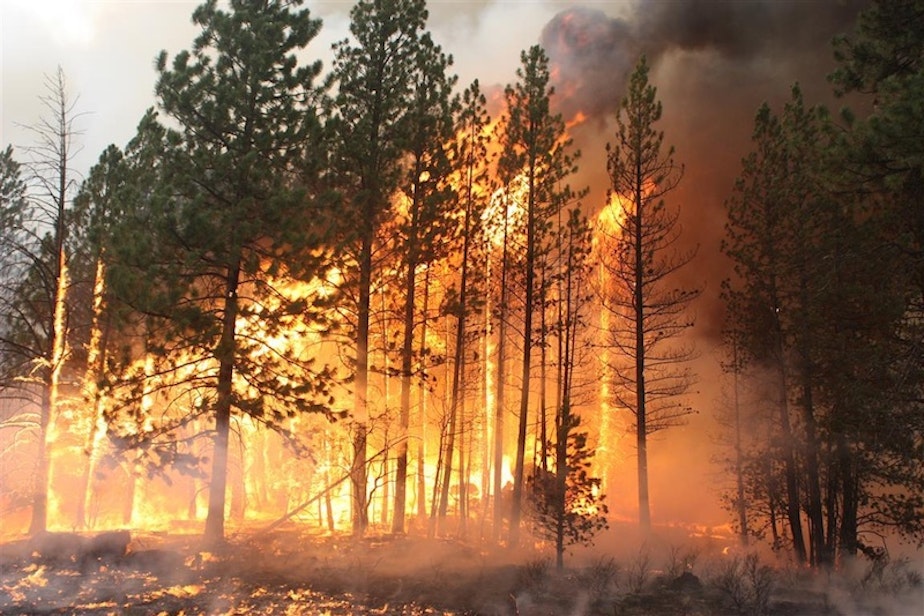Many states fail to adequately budget for wildfire costs, study says

Many states are failing to adequately budget for wildfire costs before, during and after fires, according to a new report from The Pew Charitable Trusts. This lack of proper budgeting can strain resources and pull funds away from efforts to prevent and prepare for wildfires, according to the report.
“As fires have grown, so have government spending on the costs associated with them,” said Colin Foard, manager of the Fiscal Federalism Initiative for The Pew Charitable Trusts, a non-profit organization that analyzes public policy.
For example, in Washington, the state averaged $24 million annually for wildfire suppression from 2010 to 2014. That spending more than tripled, averaging $83 million from 2015 to 2019.
The Pew study looked at how states budget for wildfire costs, the challenges with those budgets, and what can be done to help.
While it’s difficult to track most state wildfire spending, Foard said Washington state has made strides to better monitor and report its wildfire spending. States should make comprehensive wildfire spending information continually available to policymakers and the public, he said.
Sponsored
Washington has taken several steps to share that information, including a Joint Legislative Audit and Review Committee that has evaluated suppression and forest health spending, according to the report. In recent years, the Department of Natural Resources published suppression spending information. The department also publishes the sources and location of mitigation funding in an online forest health tracking tool.
According to the Pew report, which looked in-depth at six states including Washington, each state primarily used general fund appropriations to pay wildfire costs upfront. Revenue for the general fund comes from state taxes and fees and is used for general state operations.
“To the extent that more expensive and unpredictable wildfires are being pulled from that same pool of money, it’s a problem for state fiscal stability moving forward,” Foard said.
On private forest land, Washington state charges landowners a Forest Fire Protection Assessment, a fee that pays for fire preparedness activities, for example purchasing fire engines and training crews. The assessment includes a $17.50 flat fee and 27 cents for each acre over 50 acres, according to the Department of Natural Resources.
The department also charges a Landowner Contingency Assessment to those private landowners. The fee pays for emergency fire protection if the landowners negligently start a fire on their property. The assessment includes a $7.50 yearly flat fee for 50 acres or less. For more than 50 acres, the additional acre fee can’t be higher than 15 cents per acre, according to the department.
Sponsored
Often, wildfire suppression takes up the bulk of funding needs, Foard said.
To estimate future fire suppression appropriations, Washington takes a 10-year rolling average of historical costs and removes the two highest and two lowest-cost years. The state then averages costs from the remaining years.
According to the Pew report, backward-looking estimates often are insufficient, straining state budgets that need to cover spending gaps with supplemental appropriations.
For example, in 2019, Washington needed $80.5 million in supplemental appropriations above what had been planned, according to the report.
“In recent years in particular, the approaches states have been using to budget for fire suppression have consistently been falling short and are proving increasingly disruptive to budgets,” Foard said.
Sponsored
In addition, he said, when states spend so much on fire suppression efforts, funding often is shifted away from fire prevention and preparedness efforts.
One way to help with that, he said, is to establish separate funds for mitigation efforts. In 2021, Washington invested $500 million over eight years to fund wildfire preparedness and prevention efforts.
Moreover, Washington’s 20-year Forest Health Strategic Plan will help the state prioritize forest health treatments and at-risk communities, according to the Pew report.
Still, the scale of wildfires can be overwhelming, Foard said, especially as the changing climate creates worsening wildfire conditions and longer fire seasons.
This year, more than 140,000 acres burned in Washington, far fewer than the 10-year average of 470,000 acres, according to the Department of Natural Resources.
Sponsored
“We just have to figure out how to scale up mitigation treatments to match the new reality,” Foard said.
To do that, the report recommends lawmakers compare actual spending on wildfire costs rather than estimating from historical records.
“States are regularly forced to supplement initial appropriations and should therefore consider adjusting how they estimate that initial number,” Foard said.
States also should invest as much funds as possible in wildfire mitigation efforts, such as prescribed burns, forest thinning and land-use planning, Foard said.
It’s important to make sure other fire spending needs don’t pull funds away from consistent fire mitigation spending, he said.
Copyright 2022 Northwest News Network
